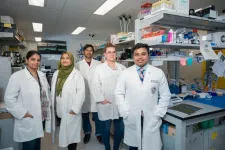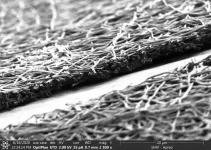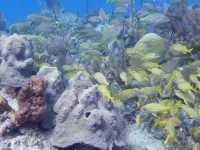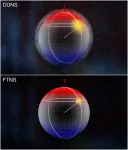(Press-News.org) EL PASO, Texas (June 6, 2024) — Researchers at The University of Texas at El Paso are developing a new therapeutic approach that uses nanoparticles for the treatment of skin and lung fibrosis, conditions that can result in severe damage to the body’s tissues.
Md Nurunnabi, Ph.D., is an associate professor in UTEP’s School of Pharmacy and the lead researcher on two studies published this June in the medical Journal of Controlled Release; one study focuses on skin fibrosis and the other on lung fibrosis.
“We are closer than ever to developing a safe, effective and reliable approach to treating fibrosis,” Nurunnabi said.
Fibrosis is a condition in which the tissues in an organ — such as the skin, lungs, liver or kidneys — become thicker and stiffer, according to Nurunnabi. This can have multiple damaging effects, such as the lungs not being able to hold enough oxygen or blood vessels becoming narrower, leading to high blood pressure.
“I studied fibrosis during my postdoctoral training but became interested in focusing on it in my lab during the COVID-19 pandemic,” Nurunnabi said. “I observed that many people were passing away not because of COVID itself, but because of the inflammation and fibrosis caused by the viral infection in the lungs. Our lab focuses on developing nanotechnology that can target specific cells.”
Fibrosis can occur as a side effect of chemotherapy or the result of a viral infection or autoimmune disease, a condition in which the body’s immune system attacks its own cells. For example, with an autoimmune condition, the body kills cells called fibroblasts that help form connective tissue. The body then produces more collagen than it needs, which leads to fibrosis.
Nurunnabi’s team focused on designing a nanoparticle that could target the cells that are responsible for fibrosis development and progression without disturbing the “good” cells necessary for the body’s healthy functioning. Rather than killing the ”bad” cells, the team was successful in modifying them so that they no longer produced excess collagen, in effect rehabilitating the cells. The studies were conducted in the test tube and in mice.
"Dr. Nurunnabi's research into skin and lung fibrosis sheds light on the devastating impact of these conditions, whether acute or chronic,” said José Rivera, Pharm.D, founding dean of the School of Pharmacy. “His findings offer hope for improved treatments that could significantly increase life expectancy and enhance the quality of life for affected individuals."
Nurunnabi’s lab is funded through a collaborative program between UTEP, the National Institutes of Health and Baylor College of Medicine, as well as a pilot grant from the National Scleroderma Foundation to conduct research related to treatment of fibrosis.
About The University of Texas at El Paso
The University of Texas at El Paso is America’s leading Hispanic-serving university. Located at the westernmost tip of Texas, where three states and two countries converge along the Rio Grande, 84% of our 24,000 students are Hispanic, and more than half are the first in their families to go to college. UTEP offers 170 bachelor’s, master’s and doctoral degree programs at the only open-access, top-tier research university in America
END
UTEP pharmacy researchers develop potential treatment for fibrosis
Nanoparticles target and rehabilitate cells responsible for disease
2024-06-06
ELSE PRESS RELEASES FROM THIS DATE:
Employers coast to coast join movement to turn bystanders into lifesavers
2024-06-06
DALLAS, June 5, 2024 — Nine out of 10 people who suffer cardiac arrest outside of the hospital die, and cardiopulmonary resuscitation (CPR), especially if performed immediately, can double or triple survival rates.[1] That is why the American Heart Association, celebrating 100 years of lifesaving service, will broaden efforts to drive CPR education at the community level through the Heart Walk® campaign. Heart Walk is the Association’s largest community-based activation engaging more than 220 cities ...
Flavor restrictions affect tobacco buyers differently depending on socioeconomic status, researchers say
2024-06-06
Restricting menthol flavor in cigarettes while making nicotine replacement therapy, such as a skin patch that can help ease withdrawal, more available and affordable has the potential to reduce socioeconomic disparities in tobacco use.
That was one of the findings in a study published in May in Nicotine and Tobacco Research that marks a new use of existing data from the Fralin Biomedical Research Institute at VTC’s Addiction Recovery Research Center. Researchers analyzed data from their Experimental Tobacco ...
Botanists and archaeologists receive National Science Foundation grant to study Mediterranean history
2024-06-06
It’s an unusual collaboration. Botanists and archaeologists don’t often work together, unless they’re studying the way people have used plants through time. But a new four-year grant from the National Science Foundation is shaking things up. It provides more than $1 million to study how Mediterranean plants that people have largely ignored evolved and diversified in one of the most formative periods of human history.
“The Mediterranean is at the crossroads of Europe,” said Nicolas Gauthier, curator ...
Silkworms help grow better organ-like tissues in labs
2024-06-06
DURHAM, N.C. -- Biomedical engineers at Duke University have developed a silk-based, ultrathin membrane that can be used in organ-on-a-chip models to better mimic the natural environment of cells and tissues within the body. When used in a kidney organ-on-a-chip platform, the membrane helped tissues grow to recreate the functionality of both healthy and diseased kidneys.
By allowing the cells to grow closer together, this new membrane helps researchers to better control the growth and function of the key cells and tissues of any organ, enabling them to more accurately model a wide range of diseases and test therapeutics.
The research appears June 4 in the journal Science Advances.
Often ...
Scientists ‘read’ the messages in chemical clues left by coral reef inhabitants
2024-06-06
What species live in this coral reef, and are they healthy? Chemical clues emitted by marine organisms might hold that information. But in underwater environments, invisible compounds create a complex “soup” that is hard for scientists to decipher. Now, researchers in ACS’ Journal of Proteome Research have demonstrated a way to extract and identify these indicator compounds in seawater. They found metabolites previously undetected on reefs, including three that may represent different reef organisms.
Plants and animals living in coral reefs release various substances, from complex macromolecules to individual amino acids, into the surrounding water. To determine ...
Identifying risk factors for native coronary atherosclerosis progression after percutaneous coronary intervention
2024-06-06
https://www.scienceopen.com/hosted-document?doi=10.15212/CVIA.2024.0033
Announcing a new article publication for Cardiovascular Innovations and Applications journal. This study was aimed at investigating factors influencing the progression of native coronary atherosclerosis after percutaneous coronary intervention (PCI).
A cohort of 462 patients was classified into progressive (n = 73) or non-progressive (n = 389) groups according to the presence of native coronary atherosclerosis progression on coronary angiography. ...
Mapping noise to improve quantum measurements
2024-06-06
One of the biggest challenges in quantum technology and quantum sensing is “noise”–seemingly random environmental disturbances that can disrupt the delicate quantum states of qubits, the fundamental units of quantum information. Looking deeper at this issue, JILA Associate Fellow and University of Colorado Boulder Physics Assistant Professor Shuo Sun recently collaborated with Andrés Montoya-Castillo, Assistant Professor of Chemistry, and his team to develop a new method for better understanding and controlling this noise, potentially paving the way for significant advancements in quantum computing, ...
Tiny predator owes its shape-shifting ability to “origami-like” cellular architecture
2024-06-06
For a tiny hunter of the microbial world that relies on extending its neck up to 30 times its body length to release its deadly attack, intricate origami-like cellular geometry is key. This geometry enables the rapid hyperextensibility of the neck-like protrusion, for single-celled predator Lacrymaria olor, a new study reports. The findings not only explain L. olor’s extreme shape-shifting ability but also hold potential for inspiring innovations in soft-matter engineering or the design of robotic systems. Single-celled protists are well known for their ability to perform dynamic morphological changes in ...
Widespread use of high-assay low-enriched uranium raises significant nuclear security concerns
2024-06-06
In a Policy Forum, R. Scott Kemp and colleagues argue that promoting new nuclear reactor technologies using high-assay low-enriched uranium (HALEU) threatens the international system of controls that has prevented nuclear weapons proliferation for over 30 years. “Governments and others promoting the use of HALEU have not carefully considered the potential proliferation and terrorism risks that the wide adoption of this fuel creates,” write Kemp et al. The authors warn that if HALEU becomes a standard reactor ...
JWST uncovers features of very-low-mass star’s protoplanetary disk that influence planet composition
2024-06-06
James Webb Space Telescope (JWST) observations have revealed abundant hydrocarbons in the protoplanetary disk surrounding a young, very-low-mass star – findings that provide novel insights into the chemical environment from which many terrestrial planets, in particular, are born. Planets form in disks of gas and dust that orbit young stars. Observations show that terrestrial planets form more efficiently than gas giant planets around very-low-mass stars (VLMSs) – those with less than 0.3 solar masses. Although the chemical compositions of the inner disk regions around higher mass stars ...
LAST 30 PRESS RELEASES:
Why nail-biting, procrastination and other self-sabotaging behaviors are rooted in survival instincts
Regional variations in mechanical properties of porcine leptomeninges
Artificial empathy in therapy and healthcare: advancements in interpersonal interaction technologies
Why some brains switch gears more efficiently than others
UVA’s Jundong Li wins ICDM’S 2025 Tao Li Award for data mining, machine learning
UVA’s low-power, high-performance computer power player Mircea Stan earns National Academy of Inventors fellowship
Not playing by the rules: USU researcher explores filamentous algae dynamics in rivers
Do our body clocks influence our risk of dementia?
Anthropologists offer new evidence of bipedalism in long-debated fossil discovery
Safer receipt paper from wood
Dosage-sensitive genes suggest no whole-genome duplications in ancestral angiosperm
First ancient human herpesvirus genomes document their deep history with humans
Why Some Bacteria Survive Antibiotics and How to Stop Them - New study reveals that bacteria can survive antibiotic treatment through two fundamentally different “shutdown modes”
UCLA study links scar healing to dangerous placenta condition
CHANGE-seq-BE finds off-target changes in the genome from base editors
The Journal of Nuclear Medicine Ahead-of-Print Tip Sheet: January 2, 2026
Delayed or absent first dose of measles, mumps, and rubella vaccination
Trends in US preterm birth rates by household income and race and ethnicity
Study identifies potential biomarker linked to progression and brain inflammation in multiple sclerosis
Many mothers in Norway do not show up for postnatal check-ups
Researchers want to find out why quick clay is so unstable
Superradiant spins show teamwork at the quantum scale
Cleveland Clinic Research links tumor bacteria to immunotherapy resistance in head and neck cancer
First Editorial of 2026: Resisting AI slop
Joint ground- and space-based observations reveal Saturn-mass rogue planet
Inheritable genetic variant offers protection against blood cancer risk and progression
Pigs settled Pacific islands alongside early human voyagers
A Coral reef’s daily pulse reshapes microbes in surrounding waters
EAST Tokamak experiments exceed plasma density limit, offering new approach to fusion ignition
Groundbreaking discovery reveals Africa’s oldest cremation pyre and complex ritual practices
[Press-News.org] UTEP pharmacy researchers develop potential treatment for fibrosisNanoparticles target and rehabilitate cells responsible for disease





